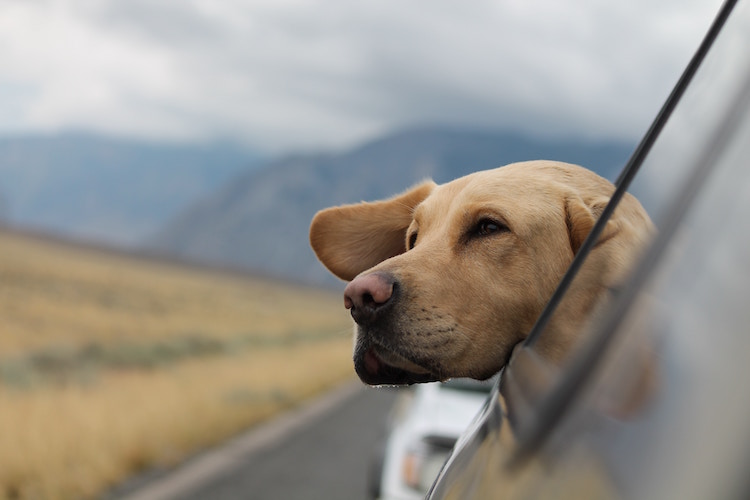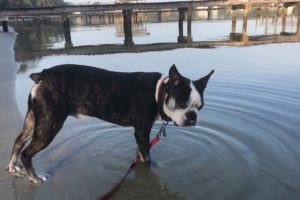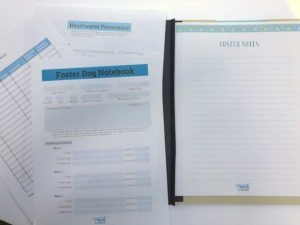The other day as I was driving to my parent’s home, I saw this dog riding in the front seat of the car with his person, the dog’s head sticking out of the window, ears flapping in the wind. And he was baying at the top of his lungs.
Pure joy.
I laughed out loud.
And then, I worried about him. Was he buckled in?
Then, I thought about y’all and your fostering activities and how many times a week you transport a rescue dog. How easy is it to put them in the front seat, roll down the window just enough for their snout to stick out, and let them smell the air and feel the breeze! They love it, and we love making our foster dogs happy.
While Pet Travel Safety Day is always on January 2nd, I’m usually not thinking about traveling with my pets as I’ve just returned home from a busy holiday season. That said, when I thought about this topic, I thought about you who foster rescue dogs and your specific needs and issues. It’s probably safe to say that you travel with your foster dogs more than you do with your individual pets! Are your foster dogs as safe as they can be during their car rides with you? Do you use dog transport safety guidelines?
Car Safety Equipment For Dogs
We already know you need equipment to foster dogs, and the more you foster, the more “stuff” you need.
The same is true when we want to transport dogs safely. In order to safely move your foster dog from point A to point B, you need the right stuff!
But first, let’s talk about car travel safety for dogs, OK?
Dog Transport Safety is an Essential Skill
What is the safest way to transport a dog in a car?
Ask this question to 10 people, and you will likely get 10 different answers. Many people say having dogs harnessed into a restraint system such as a seatbelt harness or doggie car seat is the safest, and others swear by crates or car carriers.
Surprisingly, many of us use nothing – allowing our furry friend to ride loose in the car, standing on all fours, nose out the window. We know better, don’t we?
Check out this factoid:
In a car crash at 35 miles per hour, an unrestrained 60-pound dog becomes a 2,700-pound projectile. The force of that impact could kill both the dog and the car’s human occupants. Yet many of us drive around every day with our dogs just sitting on the back seat, or even on our laps.
Wes Siler, Outsideonline.com
The Dog Transport Safety Experts Say…
First, most pet experts advise to never allow your pet to ride in the front seat, at all, ever. For one, it can be pretty distracting to have a pet sitting right next to you, like an adorable puppy or a newly rescued dog who deserves to experience love a.s.a.p. I know that feeling, I’ve sprung many a pitiful pup from the county slammer. I want to comfort them and let them know that everything is going to be OK.
Besides being distracting, the front seat or your is not the safest part of your car, either.
In the event of an impact, there’s a lot of extra room in the front compartment, which means there’s a lot of room to get knocked about or worse — fly through the windshield or even fly into you. I can’t imagine the injuries.
Got airbags? You should worry, too. A deployed airbag can seriously injure a dog riding in the front seat.
Dog Transport Safety Means Restraint
Experts also advise securing a travel carrier or crate in the back seat, or 2nd row of an SUV/Van rather than in the very back, where you’d store, lets say, your groceries. When you have a crate/carrier secured more towards the center of your auto, it’s farther away from the automobile’s crumple zones. Makes total sense when you think about it.
If you strictly go by the guidelines of the Center for Pet Safety, (CPS) an organization that certifies transportation equipment for pets, there are very, VERY few products that pass their safety test, and those that do are cost prohibitive for most. For example, the Gunner G1 crates start at $399 for their smallest size. CPS shouldn’t be dismissed, however – they do provide safety notices when they discover a product design to be pretty unsafe to use.
It is my experience and my personal belief that the safe use of a crate or a harness during car transportation may depend upon two things: The automobile and the dog.
Exploring Car Safety Equipment For Dogs Revealed Major Gaps In The Industry
I usually transport and foster dogs under 30 lbs. And, I drive a 4-door sedan. I can easily fit two crates on my back seat and secure them so that the crates cannot move.
Giant Breeds Have Few Equipment Options
But, as I started reading and researching products for my list, I realized that if you need to transport a large or giant breed dog, there aren’t a lot of options!
I reached out to Stephanie Seger of Big Dog Mom and parent to two very big Mastiffs. She’s always on the go with her dogs and I knew she’d already done her homework. I wanted her expert guidance to help those of you who rescue and transport large breeds.
Stephanie acknowledges car safety equipment choices are limited for big dogs, but she remains pretty emphatic: “I recommend that large and giant breed dog owners use something to restrain or confine their dogs. It is not safe to allow them free-run of a moving vehicle.” She adds, “it puts the dog at significantly greater risk of injury or death” if they are not restrained.
You can’t argue with it! if a 60 pound dog traveling at 35 miles per hour becomes a 2700 lb projectile on impact, can you imagine the force of a 200 pound dog? Yikes!
Stephanie installed a pet barrier in her automobile to keep her dogs away from the front seats. A pet barrier is typically installed behind the front seats of a vehicle and, depending upon the design, can offer a top-to-bottom, side-to-side shield, preventing a dog from being thrown from the back seat or cargo area all the way to the front. It also prevents a loose dog from climbing into the front seats when you are driving, something you don’t want a dog to do, as sweet as it is.
So, my rescue dog transport peeps, you need to have a pet barrier installed in your vehicle.
Your choice of pet barrier may depend upon your vehicle.
Big Dog Transport Safety
Stephanie’s Lincoln Navigator is quite spacious and comfy for her giant dogs, but it also provides plenty of room to slip and slide, even when restrained. Stephanie is in love with the WeatherTech Cargo Liner, a recent addition to her travel-safety equipment, and it’s been a game-changer for her dogs. WeatherTech makes cargo liners for most vehicles. Type in your make and model.
Because her dog Junior weighs 245 pounds and Sully is a robust 220 pounds, travel in crates is a bit of a challenge. Actually, so is finding a harness that fits! Stephanie knows the struggle. “The only harness that fits my Junior is made by Kurgo, and Sully, who’s built smaller, wears one from Ruffwear.” Both of these companies design harnesses for car travel. They are not cheap, but they are some of the safest harnesses on the market for larger breed dogs. (Note: Center for Pet Safety does not endorse tethered harnesses, however, there are no other options for large breed dogs that I could find at the time of this writing.)
Stephanie also recommends purchasing equipment to help large breed dogs safely get in and out of a larger vehicle. She uses a Twistep, and loves it. It’s pricey, but if you foster giant breed dogs exclusively, this device may be a bargain compared to a soft-tissue or joint injury.
If you love big dogs or if you are fostering a large breed dog, check out Stephanie’s website, BigDogMom.com. She is super-knowledgeable and a wonderful resource for large-breed dogs and their humans.
Why Transporting a Rescued Dog May Be Different than Transporting Your Personal Pet
Dog Transport Safety for newly rescued dogs requires a tweaking of the guidelines.
- Do you really know this dog? Does this dog really know you? It takes weeks, even months for a dog to truly settle into a home and form a relationship with a human. If you just picked up a dog from a shelter, or from the former foster home, you need to use all of your safety methods to avoid elopement, injury, a bite, or a messy clean-up. Every new dog is a flight risk.
- Plan for the unknown. If you are transporting a newly rescued dog, be prepared for all senarios. You may be asked to transport a dog that has motion sickness, motion anxiety, or a dog that’s a known runner. Under-socialized dogs who’ve never, ever ridden in a car before may find the experience frightening. Have you ever transported a loose dog who began having a panic attack while you are traveling on the interstate? I have, and you really don’t want to. It scared me!!
Bottom line: be prepared for everything and work to prevent those uh-ohs!! - Respect the known. We can be our own worst enemy when it comes to taking the advice or information from someone who is handing you a dog. “I know what I’m doing” are famous last words, and I’ve had a few “I told you so” moments during my time as a foster coordinator. If someone says to you, “this dog had an upset stomach this morning,” tarp your car. Or, “I think this dog doesn’t like a leash/collar on,” believe them until it’s proven otherwise in a safe/secure setting, not in your car, on the road. Transport is no place for assessment.
- You have to manage the environment for illnesses and/or parasites. Well, you don’t HAVE to, but you do want to. I can’t tell you how often I’ve picked up a flea-covered, snot-nosed, sneezy, coughing dog and put them in my car. You do it too, I know you do! I take steps to reduce the spread of contagions or parasites my transport may have. (like fleas) Keeping my personal pets well starts with managing the environment in my car. Added benefit? You won’t have to wipe down your entire car with disinfectant three times a week.
- Paperwork, paperwork, paperwork! If you are transporting a rescued dog, you always should have paperwork with you, always! That paperwork should include emergency contact information (the rescue/shelter is the owner of the dog) and your dog’s rabies certificate. (cause I know most of you don’t put the rabies tag on a collar) Picking up a dog from the shelter? You want a copy of their kennel card and any vet care/vaccines given. Picking up a newly vetted dog from the veterinarian? At a minimum, you want the rabies certificate. Picking up a dog after surgery/spay/neuter? You want to make sure you have all post-op care instructions and any/all medications. Remember: Transporting a rescue dog usually means paperwork. Tell yourself: no paperwork? I’m not rolling.
- ID your transport dog. Use a tag, or in the absence of a tag, use masking tape on the collar and write a phone number with a sharpie marker. Write on the dog’s belly if you have to – get an ID on that dog.
The Crates I Use for Safe Travel
My wire crates will not pass the CPS safety test. Heck, it doesn’t pass the Otis test, as he can bend the bars with his jaws. But that is what I have to use. I choose a crate size appropriate for my dog’s size and for my ability to lock that crate in place. A moving crate is just as dangerous (or more so) than a moving dog. When it comes to transport safety, comfort takes a back seat to security. Pun intended.
Think about it this way: Why aren’t we severely injured when we are on a rollercoaster or amusement park ride? We are certainly thrown about on the loops, swoops, twists, and turns! Truth is, we are buckled in so securely, we can’t move much.
If you transport using crates, select the crate that fits your car and that you can lock down. If wedging it between the front seat and back seat is the most secure, do that. If it’s using latches in the forward space of your SUVs cargo area (seats down) do that. In the event of an accident, you want the crate away from your car’s crumple zones and you want it to stay put.
Use these seatbelt straps to help secure your wire crate to the back seat.
So – if you are transporting a tiny dog or puppy, sitting that carrier on the back seat isn’t safe enough. Make sure it is somewhere where it will not slide or roll or fly through the air. You are carrying precious cargo!
You also may consider using the Dog Seat Cover and Hammock – it comes complete with seatbelt straps.
Harnesses you may consider
I don’t typically transport larger breed dogs, so I don’t use seatbelt harnesses, but they are absolutely useful if you have no other option to keep your dog restrained, or you are die-hard anti-crating.
Check out the The Ruffwear Load Up Harness
Pet Travel Kit
Be Organized!
Your travel kit does you no good if you can’t find the item you need! I love this trunk organizer – it’s not too big, and it has a pocket on the side where I can keep important documents, an extra leash, meds, whatever I may need quick access to urgently!
For an upgrade or for you serious dog transporters, I love this Trunk Organizer for the extra compartments. Look at those pockets! Plus, it collapses shut when you aren’t using it. But really, we will always have stuff in it, won’t we!
Prepare for delays – have travel bowls! (And food/water!)
I was going to recommend my collapsible water bowl that I’ve had in my glove compartment for.ever, but I pulled it out to look at it, and it was sorta gross. Fact: I hadn’t used it in a while, and therefore, hadn’t cleaned it. Hmmm. That isn’t a good discovery if you find yourself delayed and your pup needs water. Yuck.
I now keep a stainless bowl in the trunk of my car. This is a “basic model” and honestly, I don’t care for that little rubber no-skid cover at the bottom. That thing gets gross over time, and it can harbor contagions. Take it off! I don’t need one that is made by a designer or has one fancy feature or the other – this is for my car. I don’t care about spill-proof designs, or stabilizing straps, etc. I don’t serve water while I’m rolling.
I should add a second or third bowl – for infection control purposes – and will, now that I think about it! Stainless bowls are perfectly stackable and don’t really take up much room, and are easily disinfected along with my other transport gear.
Prepare for Poop!
While poop isn’t a safety hazard, it does make for a miserable ride. And, poop happens, my friends.
You’ll want to store the Earth Rated Poop Bags in your vehicle. I promise you, if you’ve never transported a bag of poop in your car, you will. And when you do, you’ll thank me for suggesting these bags!
The Earth Rated Poop bags have several sizes and designs. I like the Extra Thick and Strong poop bags. They also have dog wipes, too! If you like the dispensers to hang on your leash, they have an awesome design. They offer their products in a variety of quantity options and you can choose between lavendar-scented or unscented.
Their customer service policy is exceptional.
Wipes and More Wipes!
Speaking of wipes, you are going to need cleaning wipes. I pick up Good and Clean Disinfectant wipes by the armful at Dollar Tree. I use these for the occasional accident, muddy paw print, or slobber smear.
You Need a Moisture Barrier!
Always, always, always have a waterproof tarp in your car. You can open them up all the way, fold them to fit underneath a crate, or even use them as a cover over a crate to minimize the sneezy spread of cooties.
In addition to tarps, you’ll appreciate having absorbent pads, either the disposable “puppy training pad” type or the washable, Chux Pads. Personally, I like the Chux pads because they are more durable, are washable, and honestly, over time, are more bang for your buck.
You Need More Than One Leash
I have two kinds of leads I may use during transport: a flat, clip on leash and a slip lead.
The clip on lead
I have a flat leash that is similar to the Vivaglory Padded Traffic Handle Dog Leash. I do not like my leash. I like the looks of this one and will be purchasing it in the near future. I use front-clip harnesses for my foster dogs, and this leash used with the front-clip will give me more control should I ever need to quickly redirect my dog. The grips look real sturdy and easy to hang on to without risk of friction injury!
I also recommend this leash to individuals taking their dog through heartworm treatment. That extra loop makes it easier to help a dog navigate steps at a safe pace.
The slip lead
I bought the Mendota slip lead last year and I really like it. It’s soft and rolled and when properly used, the ring slides immediately when tension on the lead is reduced. In terms of safety during transport, I’ll opt for a martingale collar over a slip lead, but when you need to get a lead around the head of a collarless dog, a lead like this is what you want.
Collars
Flat collars – buckles or snap closure
Flat collars can be found everywhere at nearly every price point, even at the dollar store. ALERT: I actually stopped buying them at the dollar store because I found that some of the plastic snap closures didn’t catch all the way, and I ended up with a loose dog (thankfully inside!) a time or two! YIKES! So, if you are shopping the dollar store collars, snap that buckle and give it a good pull before you buy it.
Personally? I prefer a flat collar with a buckle rather than the snap closure. In my opinion, a buckle collar is safer on a dog that you don’t know.
I also prefer a wider collar to a skinny one. Wider collars are safer against the dog’s trachea.
Flat collars are useful for ID tags, and an extra layer of safety. I do not use leash up a stranger dog using only a flat collar, FYI.
Martingale Collar
Also know as a “greyhound collar,” the martingale is a limited slip collar. When tension is applied, the collar will tighten around the neck of a dog, but only to a point, given the collar is properly fitted. This prevents a dog from pulling it’s head out of a collar, and gives you a bit longer than a nanosecond to get a spooked dog under control. I use a Martingale collar in conjunction with a properly fitted harness.
How To Measure And Fit A Martingale Collar
The Harness
I am not going to drop a product recommendation here because I’ve learned the hard way: Not every harness design is going to fit every dog you foster. Honestly? I have about 15 dog harnesses – different vendors, sizes, and designs.
The best harness is the one that fits.
And I know a poorly fitted harness is worthless on a dog that’s unknown or a known flight risk. It takes only a couple of seconds for a dog to peel out of a ill-fitted harness. I fit a dog the best I can, add a martingale collar, and double leash. The smaller the dog, the less I rely on a harness and the more I rely on my arms, martingales, crates and a swift transfer. I’d rather clean up tee-tee than lose a dog. You feel me?
Most of my harnesses are similar to the Kurgo harness (link above) because of the multiple adjustment points and the front clip and back clip options.
That said, If my foster dog has or will be in my care for longer than a couple of hours, they get a properly fitted harness. If my budget can’t handle buying one on my own, I’m looking to donors for a gift-in-kind to the rescue for whom I’m fostering.
It’s your job to keep a foster dog safe. Do what you have to and ask for whatever you need. Insist on it.
In summary, you have a huge responsibility to the rescue dog you are transporting, whether you are part of a multi-leg, multi-state transport plan or you are simply transporting a dog from shelter to vet, vet to home, or home to forever home. Please keep them safe. Protect them from injury or illness. This life has been saved by rescue. It is precious cargo.
Do you have a dog safety transport guideline you follow? Drop us a line!
Popular Posts
How To Foster Dogs – 10 Skills You Need To Know
How To Choose A Dog Rescue Agency
Let Your Foster Dog Go – Tips For Adoption




